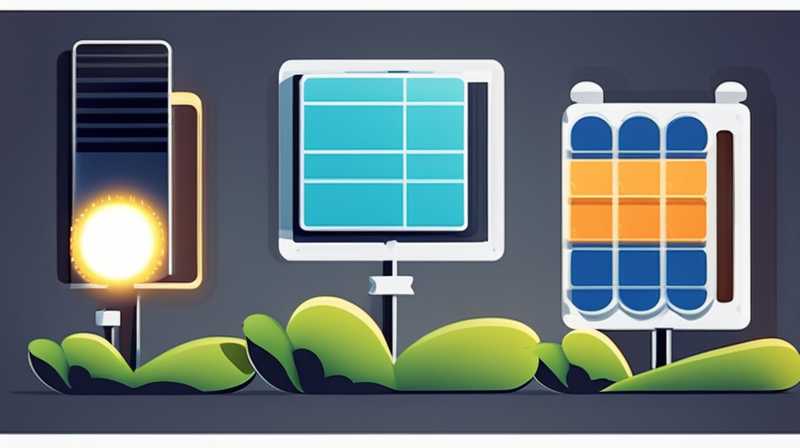
To install solar lights effectively on the right corner, follow this structured approach: 1. Determine the Ideal Location, 2. Gather Necessary Tools, 3. Prepare the Installation Site, 4. Mount the Solar Light Properly, 5. Test the Functionality Thoroughly. Each point addresses different facets of installation, with the ideal location being crucial since it impacts sunlight absorption and, consequently, the light’s efficiency. The process often begins with choosing a corner that maximizes sun exposure while considering aesthetics and functionality.
1. DETERMINING THE IDEAL LOCATION
When it comes to outdoor solar lighting, selecting the right location carries great significance. Solar lights operate on the principle of absorbing sunlight throughout the day and converting it into electrical energy for nighttime illumination. Therefore, the first step involves assessing sunlight exposure. A south-facing corner is commonly preferred as it typically receives the most direct sunlight.
Additionally, considering the surrounding environment is essential. Objects such as trees, buildings, or fences can block sunlight, leading to inadequate charging. Moreover, evaluating the intended role of the lights—be it for decorative purposes, safety, or pathway lighting—will further guide the location selection. A well-lit area not only enhances visibility but also adds a sense of security to homes and outdoor spaces.
Furthermore, take into account seasonal changes during installation. Shadows cast by trees or buildings may shift as seasons change, potentially affecting light performance. After determining the optimal spot for solar lights, the next step is to gather the necessary tools and components for the installation process.
2. GATHERING NECESSARY TOOLS
Before diving into the installation, gathering the right tools is paramount for a smooth operation. Essential tools typically include a drill, screwdriver, measuring tape, level, and possibly a ladder if the design requires placement at a height. Each tool plays a vital role in ensuring accuracy and efficiency during the process.
Using a measuring tape to determine the precise distance from the ground or other objects will prevent misalignment and ensure that the solar lights are installed at an optimal height for illumination. Utilizing a level ensures that the lights are straight, promoting both aesthetic appeal and functional efficiency.
Beyond just tools, it is equally important to have the components of the solar lighting system readily available. This includes the solar lights themselves, mounting brackets, stakes, or any landscape fasteners that might be needed. Keeping everything at hand streamlines the installation and minimizes disruptions.
With tools and components at the ready, the next phase involves preparing the area for installation.
3. PREPARING THE INSTALLATION SITE
Prior to the actual mounting process, preparing the installation site is critical for optimal results. Start by clearing the selected corner of any obstructions. Remove debris, weeds, or foliage that might block the solar lights from receiving ample sunlight. Ensuring the area is clean not only aids the solar lights’ performance but also promotes overall safety during installation.
If the lights require drilling into a surface, it’s essential to examine the material of that surface. Hard surfaces like concrete or brick will necessitate more robust equipment, such as a masonry drill bit. Conversely, softer surfaces like wood may allow for easier installation with basic tools.
Additionally, consider the aesthetic elements of the surrounding landscape. The placement should harmonize with existing plants, pathways, or outdoor arrangements. Visual appeal is as important as functionality, ensuring that the lights not only serve a purpose but also enhance the overall ambiance of the space. After preparing the site, the next step is to mount the solar light securely.
4. MOUNTING THE SOLAR LIGHT PROPERLY
Mounting solar lights requires careful execution to ensure longevity and effectiveness. Begin by following the manufacturer’s guidance regarding the correct installation method. If mounting on a wall, mark the drill points with precision after aligning the light at the desired height.
For lights using stakes, ensure the ground isn’t overly dry or rocky, as this can hinder the installation process. Pushing the stakes into soft, damp ground often yields better results and helps secure the structure firmly. If the ground is hard, it may be productive to dig a small hole to set the stake properly while ensuring it remains upright.
Once installed, conduct a check to ensure all components are tightly secured. It’s essential that mounting brackets, screws, and stakes are tightened appropriately to prevent any movement over time. Upon finishing the installation, check the angle of the solar panels if applicable; they should face the sun optimally for maximum energy absorption.
5. TESTING THE FUNCTIONALITY THOROUGHLY
After the installation process concludes, testing is fundamental to ensure everything operates as intended. The initial test should occur the following night. Observe the brightness level of the solar lights as they illuminate their surroundings. If the light output seems insufficient, there may be adjustments needed regarding alignment or location.
Another essential testing aspect involves ensuring that the solar lights transition smoothly from day to night mode. This function hinges on the solar panel’s ability to detect ambient light levels accurately. If the lights do not switch on automatically at dusk, it may indicate a need for troubleshooting, such as checking connections or battery placement.
Regular maintenance also plays an instrumental role in sustaining functionality. Periodically clean the solar panels to avoid dust, dirt, or debris buildup that can impede sunlight absorption. Additionally, checking batteries for signs of wear or failure will prolong the lifespan of your system, ensuring reliable nighttime lighting for years to come.
FREQUENTLY ASKED QUESTIONS
IDEAL HEIGHT FOR SOLAR LIGHT INSTALLATION?
The ideal height for installing solar lights often depends on their intended use. For pathway lights, a height of 24 to 36 inches is commonly recommended since this height illuminates paths effectively without being obtrusive. Conversely, for more decorative patio lights or security lights, mounting them at a height of 6 to 8 feet will enhance visibility over a wider area. By observing these recommendations, one can maximize both functionality and aesthetic appeal for any outdoor space.
HOW LONG DO SOLAR LIGHTS LAST?
The lifespan of solar lights can vary significantly based on factors such as quality, battery type, and environmental conditions. On average, inexpensive solar lights may operate effectively for 3 to 5 years, while high-quality models can last anywhere from 5 to 10 years or longer. Maintenance practices such as regular cleaning of solar panels and timely battery replacement can enhance longevity, ensuring that the lights remain in good working order for an extended period.
CAN SOLAR LIGHTS BE USED IN SHADY AREAS?
While solar lights are designed to function efficiently in sunlight, they can still be utilized in shaded areas, although their performance will likely be compromised. If a location receives partial sunlight during the day, installing high-quality solar lights with larger solar panels may improve charging sufficiently. Alternatively, utilizing lights with built-in motion sensors could limit energy consumption by powering on only when necessary, thus extending operating periods even in less-than-ideal lighting conditions.
CONCLUDING REMARKS
The process of installing solar lights at the right corner involves a series of thoughtful decisions and actions that ultimately enhance the functionality and aesthetics of any outdoor space. By evaluating the ideal location, assembling necessary tools, preparing the site meticulously, mounting properly, and testing thoroughly, one can achieve effective results. A well-executed installation not only provides adequate visibility but also enriches the ambiance of the environment, thereby offering an additional layer of security for homes and pathways.
Implementing solar lights also contributes to environmental sustainability by harnessing renewable energy. This conscious choice exemplifies a commitment to reducing carbon footprints while enjoying enhanced outdoor experiences. It is critical to maintain the solar lights, ensuring they continue to function optimally through regular checks and appropriate cleaning procedures.
In summary, the journey of solar light installation, while straightforward, necessitates a methodical approach. Each phase, from initial planning through to testing, plays a vital role in final outcomes. By adopting best practices, you not only optimize the performance of your solar lighting fixtures but also stand to appreciate the benefits they bring to your living space. Adhering to these guidelines ensures that the integration of solar lights into your environment is a rewarding venture, both practically and aesthetically.
Original article by NenPower, If reposted, please credit the source: https://nenpower.com/blog/how-to-install-solar-lights-on-the-right-corner/


